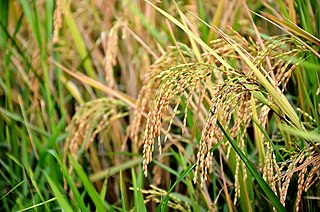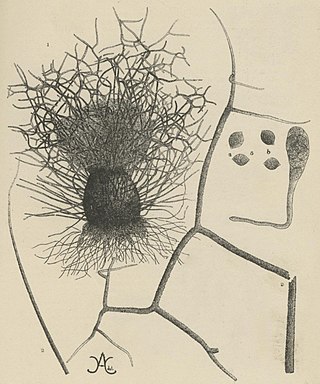
The opisthokonts are a broad group of eukaryotes, including both the animal and fungus kingdoms. The opisthokonts, previously called the "Fungi/Metazoa group", are generally recognized as a clade. Opisthokonts together with Apusomonadida and Breviata comprise the larger clade Obazoa.

Oryza sativa, also known as rice, is the plant species most commonly referred to in English as rice. It is the type of farmed rice whose cultivars are most common globally, and was first domesticated in the Yangtze River basin in China 13,500 to 8,200 years ago.

Cytorrhysis is the permanent and irreparable damage to the cell wall after the complete collapse of a plant cell due to the loss of internal positive pressure. Positive pressure within a plant cell is required to maintain the upright structure of the cell wall. Desiccation resulting in cellular collapse occurs when the ability of the plant cell to regulate turgor pressure is compromised by environmental stress. Water continues to diffuse out of the cell after the point of zero turgor pressure, where internal cellular pressure is equal to the external atmospheric pressure, has been reached, generating negative pressure within the cell. That negative pressure pulls the center of the cell inward until the cell wall can no longer withstand the strain. The inward pressure causes the majority of the collapse to occur in the central region of the cell, pushing the organelles within the remaining cytoplasm against the cell walls. Unlike in plasmolysis, the plasma membrane maintains its connections with the cell wall both during and after cellular collapse.

Magnaporthe grisea, also known as rice blast fungus, rice rotten neck, rice seedling blight, blast of rice, oval leaf spot of graminea, pitting disease, ryegrass blast, Johnson spot, neck blast, wheat blast and Imochi (稲熱), is a plant-pathogenic fungus and model organism that causes a serious disease affecting rice. It is now known that M. grisea consists of a cryptic species complex containing at least two biological species that have clear genetic differences and do not interbreed. Complex members isolated from Digitaria have been more narrowly defined as M. grisea. The remaining members of the complex isolated from rice and a variety of other hosts have been renamed Magnaporthe oryzae, within the same M. grisea complex. Confusion on which of these two names to use for the rice blast pathogen remains, as both are now used by different authors.

An appressorium is a specialized cell typical of many fungal plant pathogens that is used to infect host plants. It is a flattened, hyphal "pressing" organ, from which a minute infection peg grows and enters the host, using turgor pressure capable of punching through even Mylar.
Jonathan Dallas George Jones is a senior scientist at the Sainsbury Laboratory and a professor at the University of East Anglia using molecular and genetic approaches to study disease resistance in plants.
Microfungi or micromycetes are fungi—eukaryotic organisms such as molds, mildews and rusts—which have microscopic spore-producing structures. They exhibit tube tip-growth and have cell walls composed of chitin, a polymer of N-acetylglucosamine. Microfungi are a paraphyletic group, distinguished from macrofungi only by the absence of a large, multicellular fruiting body. They are ubiquitous in all terrestrial and freshwater and marine environments, and grow in plants, soil, water, insects, cattle rumens, hair, and skin. Most of the fungal body consists of microscopic threads, called hyphae, extending through the substrate in which it grows. The mycelia of microfungi produce spores that are carried by the air, spreading the fungus.
The parasexual cycle, a process restricted to fungi and single-celled organisms, is a nonsexual mechanism of parasexuality for transferring genetic material without meiosis or the development of sexual structures. It was first described by Italian geneticist Guido Pontecorvo in 1956 during studies on Aspergillus nidulans. A parasexual cycle is initiated by the fusion of hyphae (anastomosis) during which nuclei and other cytoplasmic components occupy the same cell. Fusion of the unlike nuclei in the cell of the heterokaryon results in formation of a diploid nucleus (karyogamy), which is believed to be unstable and can produce segregants by recombination involving mitotic crossing-over and haploidization. Mitotic crossing-over can lead to the exchange of genes on chromosomes; while haploidization probably involves mitotic nondisjunctions which randomly reassort the chromosomes and result in the production of aneuploid and haploid cells. Like a sexual cycle, parasexuality gives the species the opportunity to recombine the genome and produce new genotypes in their offspring. Unlike a sexual cycle, the process lacks coordination and is exclusively mitotic.

Dimorphic fungi are fungi that can exist in the form of both mold and yeast. This is usually brought about by change in temperature and the fungi are also described as thermally dimorphic fungi. An example is Talaromyces marneffei, a human pathogen that grows as a mold at room temperature, and as a yeast at human body temperature.
Blasticidin S is an antibiotic that is used in biology research for selecting cells in cell culture. Cells of interest can express the blasticidin resistance genes BSD or bsr, and can then survive treatment with the antibiotic. Blasticidin S is a nucleoside analogue antibiotic, resembling the nucleoside cytidine. Blasticidin works against human cells, fungi, and bacteria, all by disrupting protein translation. It was originally described by Japanese researchers in the 1950s seeking antibiotics for rice blast fungus.

A fungus is any member of the group of eukaryotic organisms that includes microorganisms such as yeasts and molds, as well as the more familiar mushrooms. These organisms are classified as one of the traditional eukaryotic kingdoms, along with Animalia, Plantae and either Protista or Protozoa and Chromista.
Chaetomium cupreum is a fungus in the family Chaetomiaceae. It is able to decay in manufactured cellulosic materials, and is known to antagonize a wide range of soil microorganisms. This species is component of the biocontrol agent, Ketomium, a commercial biofungicide. It has also been investigated for use in the production of natural dyes. Chaetomium cupreum is mesophilic and known to occur in harsh environments and can rapidly colonize organic substrates in soil. Laboratory cultures of C. cupreum can be propagated on a range of common growth media including potato dextrose at ambient or higher than ambient temperature producing cottony white colonies with a reddish reverse.

The Magnaporthaceae are a family of fungi in the order Magnaporthales. It was circumscribed by Paul F. Cannon in 1994 for a group of grass-associated fungi centered on Magnaporthe (Nakataea). Magnaporthaceae have a harpophora-like asexual morphology and are often associated with roots of grasses or cereals.

Pyricularia is a genus of fungi which was named by Saccardo in 1880.

Chaetomium elatum is a very common and widely distributed saprotrophic fungus of the Chaetomiaceae family of molds which has been found to grow on many different substances all over the world. It was first established by Gustav Kunze after he observed it growing on dead leaves. Its defining features that distinguish it from other Chaetomium species are its extremely coarse terminal hairs and the lemon-shaped morphology of its ascospores. It produces many metabolites with potential biotechnology uses including one with promise against the rice blast disease fungus, Magnaporthe grisea. It shows very little pathogenic ability causing confirmed disease in only a few plant species.
Aspergillus giganteus is a species of fungus in the genus Aspergillus that grows as a mold. It was first described in 1901 by Wehmer, and is one of six Aspergillus species from the Clavati section of the subgenus Fumigati. Its closest taxonomic relatives are Aspergillus rhizopodus and Aspergillus longivescia.
Hemibiotrophs are the spectrum of plant pathogens, including bacteria, oomycete and a group of plant pathogenic fungi that keep its host alive while establishing itself within the host tissue, taking up the nutrients with brief biotrophic-like phase. It then, in later stages of infection switches to a necrotrophic life-style, where it rampantly kills the host cells, deriving its nutrients from the dead tissues.
Magnaporthe rhizophila is a fungus species in the family Magnaporthaceae. These dark mycelial fungi are common pathogens of cereal and grass roots. Rice blast is one disease known to be caused by M. rhizophila and presents with vascular discoloration in the host organism. The fungus lives best in drier humid conditions, explaining why it is most often found in the soils of Australia, South Africa, and the Southeastern United States.
Diane G. O. Saunders is a British biologist and group leader at the John Innes Centre and an Honorary Professor in the School of Biological Sciences at the University of East Anglia. Her research investigates plant pathogens that pose a threat to agriculture. She was awarded the Rosalind Franklin Award by the Royal Society in 2022.

Fungal effectors are proteins or non-proteinaceous molecules secreted by pathogenic fungi into a host organism in order to modulate the host's immune response.











